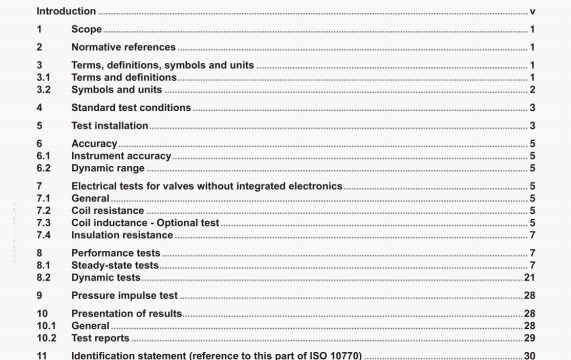ISO 10770-2 pdf download – Hydraulic fluid power – Electricallymodulated hydraulic control valves —Part 2: Test methods for three-port directional flow-control valves.
6 Accuracy
6.1 Instrument accuracy
Instrumentation shall be accurate to within the limits shown in Class B of ISO 9110-1:1990:
a) electncat resistance ± 2 % of the actual measurement;
b) pressure: t 1 % of the valve’s rated pressure drop to achieve rated flow;
c) temperature: ±2 $ of the ambéent temperature;
d) flow 2.5 % of the valves rated flow;
e) Input signal: ± 1.5 % of the electrical input signal required to ac’veve the rated flow.
6.2 Dynamic range
For the dynamic tests, ensure that the measuring equipment, amplifters and recording devices do not generate any damping, attenuation or phase shift of the output signal being recorded that would affect the measured value by more than 1 % of the measured value.
7 ElectrIcal tests for valves without Integrated electronics
7.1 General
As appropriate, perform the tests described wi 7.2 to 7,4 on all valves without integrated electronics before proceeding to subsequent tests.
NOTE Tests 7.2 to 7.4 only apply to current-driven valves.
7.2 Coil resistance
7.2.1 CoIl r,sIstanc (cold)
Carry out the test as follows.
a) Soak the complete un-energized valve at the specified ambient temperature for at least 2 h.
b) Measure and record the electrical resistance between the two leads or terminals of each coil in the valve
7.2.2 Coil resistance (hot)
Carry out the test as follows.
a) Soak the complete energized valve, mounted on a subplate recommended by the manufacturer, at its maximum rated temperature and operate the complete valve, fully energized and Without flow, until the coil temperature stabilizes.
b) Measure and record the electrical resistance between the two leads or terminals of each coil in the valve The resistance value shall be measured within 1 s of removing the supply voltage.
7.3 Coil inductance – Optional test
This test method shall not be taken to determine a definitive value of Inductance. The value obtained shall be used for comparison purposes only.
g) pressure gain versus input signal (8.1.9);
h) pressure null shift (8.1.10):
I) fail-safe function test (8.1.11).
8.1.2 Prool pressure tests (optional)
8.1.2.1 General
Proof pressure tests may be carried out Ia examine the integrity of the valve before conducting further tests.
8.1.2.2 P. A and X ports test procedure
In the test, a proof pressure Is supplied to the pressure and control ports, and the external pilot supply port of the valve with the return port open. Carry out the test as follows.
a) Apply a proof pressure 011.3 tImes the rated pressure to the pressure and control port, and the X port for at least 30 s For approximately half of this period apply the maximum input signal and for the remainder of the test apply the minimum input signal.
b) During the test examine the valve for evidence of external leakage.
C) Alter the test examine the valve for evidence of permanent deformation.
d) Record the proof pressure used in the test.
8.1.2.3 T port test procedure
Carry out the test as follows.
a) Apply a proof pressure of 1,3 times the T part rated pressure to the valve tank port for at least 305.
b) During the test examine the vatve for evidence of externaJ leakage.
c) Alter the test examine the valve for evidence of permanent deformation.
d) Record the proof pressure used in the test.
8.1.2.4 PIlot drain V port
Do not apply a proof pressure to any external pilot drain port.
8.1.3 Internal leakage and pilot flow test
8.1.3.1 General
The Internal leakage and pilot flow test shall be carried out to establish:
a) the combined leakage and pilot flow rate;
b) the pilot flow rate in the case of valves configured for external pilot drain.
8.1.3.2 Test circuit
Perform the internal leakage and pilot flow test with a hydraulic test circuit conforming to the requirements of Figure 1, initially with valves Si. S3 and S6 open and all other valves closed.
ISO 10770-2 pdf download – Hydraulic fluid power – Electricallymodulated hydraulic control valves —Part 2: Test methods for three-port directional flow-control valves
